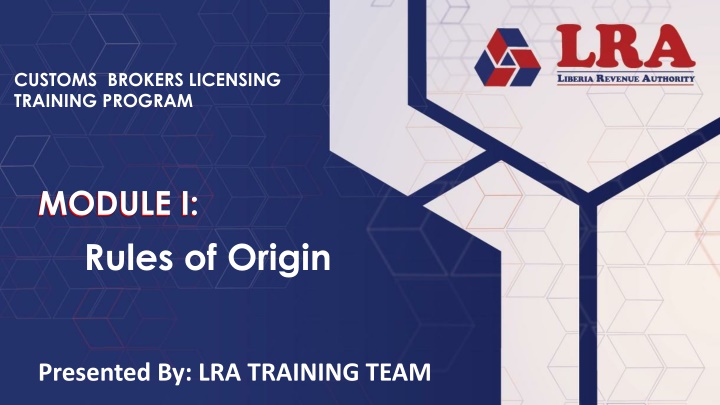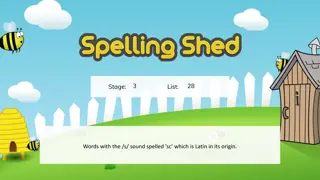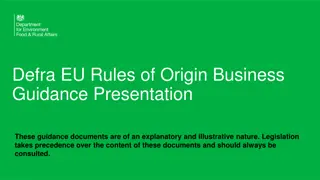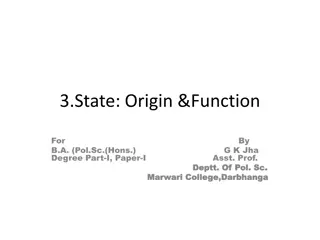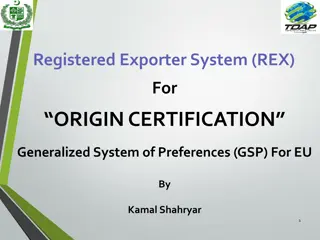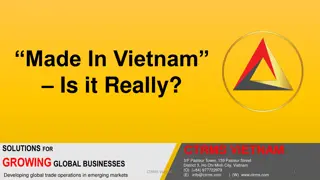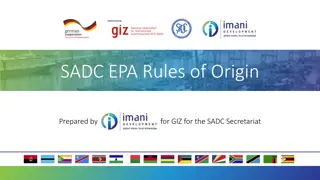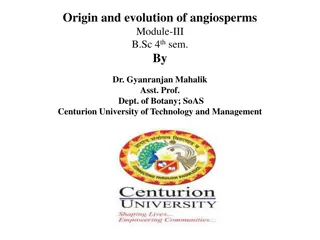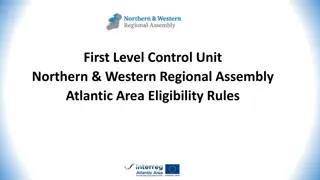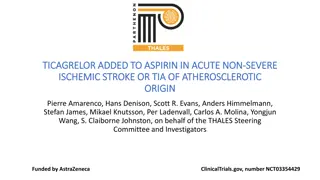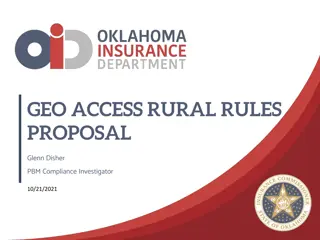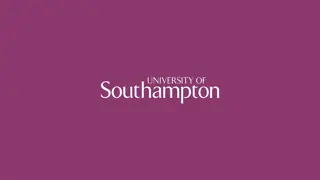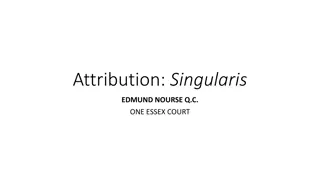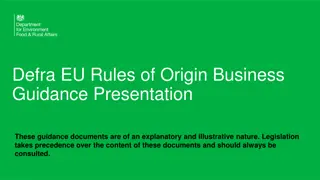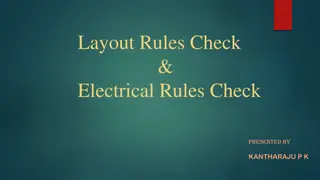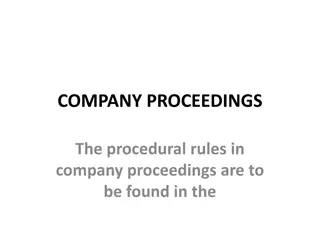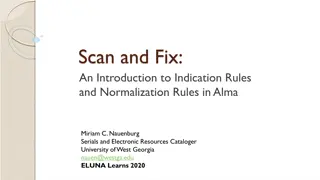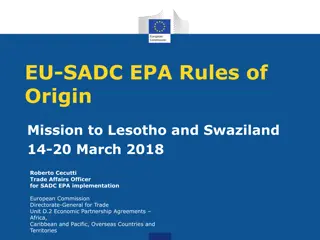Rules of Origin
Delve into the legal framework, scope, and principles of Rules of Origin (RO) in this comprehensive training module. Learn about origin conferring criteria, proof of origin, and key concepts like substantial transformation and de minimis. Strengthen your knowledge to excel in the Customs Brokers Licensing examination and enhance your expertise as a professional broker.
Uploaded on Feb 15, 2025 | 2 Views
Download Presentation

Please find below an Image/Link to download the presentation.
The content on the website is provided AS IS for your information and personal use only. It may not be sold, licensed, or shared on other websites without obtaining consent from the author.If you encounter any issues during the download, it is possible that the publisher has removed the file from their server.
You are allowed to download the files provided on this website for personal or commercial use, subject to the condition that they are used lawfully. All files are the property of their respective owners.
The content on the website is provided AS IS for your information and personal use only. It may not be sold, licensed, or shared on other websites without obtaining consent from the author.
E N D
Presentation Transcript
CUSTOMS BROKERS LICENSING TRAINING PROGRAM MODULE I: Rules of Origin Presented By: LRA TRAINING TEAM
OUTLINE 1. Objectives 2. Introduction 3. The legal basis for Rules of Origin 4. Scope of Rules of Origin 5. Proof of Origin 6. Principles for Rules of Origin 7. Origin conferring criteria 8. What is Wholly obtain? 9. Substantial Transformation criterion 10. What is Minimum Operations? 11. What De Minimis? 4
OBJECTIVES At the end of this module, the participants will be able to: Discus the legal framework of RO Discuss Rules of Origin with emphasis to Preferential and Non- Preferential rules of origin Discus the origin conferring criteria Explain the purpose of ECOWAS origin certificate 4
INTRODUCTION Rules of Origin (RO) are the means by which we determine where goods originate, i.e. not where they have been shipped from, but where they are deemed to have been produced or manufactured. 1 1 4
INTRODUCTIONcont. The participants in this course are entreated to do their utmost best to enhance their knowledge and skills to make them efficient and active participants and to contribute effectively to the conduct of the class session. This may lead to a successful pass in the Customs Brokers Licensing uniform examination. 2
INTRODUCTION cont. On the other hand, participants who may not assert themselves proficiently in this module, could stand the risk of not passing the uniform examination and may fail to be licensed to practice as professional Customs broker. 3
WHAT IS THE LEGAL BASIS OF RO? Articles I, II, III and XI of GATT 1994 (MFN) Article VI of GATT 1994 (adcd) Article XIX of GATT 1994 (sgm) Article IX of GATT 1994 & Annex II Accession to WTO Ratification of ECOWAS ETLS protocol, 2003 ACP, AGOA agreements, etc. 5
CATEGORIES OF RO Rules of Origin Preferential Rules Non-Preferential Rules 6
WHAT RULES OF ORIGIN DOES NOT COVER? WHAT RULES OF ORIGIN DOES NOT COVER? 7
WHAT RULES OF ORIGIN DOES NOT COVER? WHAT RULES OF ORIGIN DOES NOT COVER? CONT. FREEZONE GOODS UNDRER ETLS Goods transformed within the framework of economic or suspense Customs regimes or certain special regimes involving the suspension, or partial or total exemption from Customs duties on inputs, shall in no case be considered as originating products.
PROOF OF ORIGIN A Certificate of Origin (CO), issued by designated, authority in the country of export (Member State) Statement of declaration issued by the exporter or manufacturer 8
PRINCIPLES FOR PROOF OF ORIGIN Principle 1: Simplicity -The rules must be cleared and transparent in order to minimize the possibility of being applied in subjective, biased, or fraudulent manner. Else, they create needless hitches that hinder trade. 9
PRINCIPLES FOR PROOF OF ORIGINcont. Principle 2: Predictability -The rules must be amply clear, recognized and stable to enable the manufacturer to predict in a clear and secure manner how the rules will be applied to various goods, taking into account their respective destinations. 9
NO CO REQUIREMENT IMPORTS Certificate of Origin shall not be required for agricultural and livestock products, hand-made articles or articles produced with or without the use of tools, instruments or implements directly operated by the craftsman. Example: Cows, goats, carved wood, plantains, chickens, etc. 9
WHAT IS PREFERENTIAL RO? Simply means, trade agreements between governments that allow goods of their countries to be imported at reduced or zero duty rates. Example: Manu River Union Protocol (Guinea, Ivory Coast, Liberia & Sierra Leone ) 11
WHY USED PREFERENTIAL RO? It is used for the following: 1. Generalize System of Preferences (GSP); 2. Free Trade Agreement (FTA); 3. Regional Trade Agreement (RTA). Example: ACP Agreement (EU and African countries, +) 12
WHY USE PREFERENTIAL RO? Cont. Examples: 1. ACP Agreement with EU and African countries 2. ETLS Protocol (ECOWAS members states) 3. Manu River Union Protocol (Guinea, Ivory Coast, Liberia & S/Leone ) 4. AGOA Protocol/Agreement (between America and African countries, +). 18
WHAT IS NON-PREFERENTIAL RO? Article 1 of GATT 1994 defines it as those laws, regulations and administrative determinations of general application applied to determine the country of origin of goods except those related to the granting of tariff preferences. Example: Most-Favor-Nation treatment (MFN)
WHY USE NON-PREFERENTIAL RO? They are used for commercial policy measures as: 1. Anti-dumping and Countervailing duties; MFN; 2. Trade embargoes, Safeguard and retaliation measures; 3. Quantity restrictions and tariff quotas; 4. Trade statistics and Public tender; etc.
ORIGIN CONFERRING CRITERIA They are 2 criteria that confer origin on trade in goods: 1. Wholly obtained criterion 2. Substantial/sufficient transformation criterion
WHAT IS WHOLLY OBTAINED? Trade in goods considered wholly obtained includes: 1. live animals born and raised within the Member States; 2. mineral products extracted from the ground, sub-soil or sea bed of Member States; 3. vegetable products harvested within Member States; 4. products obtained from animals living or raised in Member States;
WHAT IS WHOLLY OBTAINED?Cont. 5. products obtained by hunting or fishing within member States; 6. products obtained from the sea, river and lakes within Member States by vessels belonging to the Member States; 7. products manufactured aboard ship factories belonging to member States exclusively from products referred to in paragraph (6) above;
WHAT IS WHOLLY OBTAINED? Cont. 8. used articles fit only for the recovery of raw materials, provided that such articles have been collected from users within member States; 9. scraps and waste resulting from manufacturing operations within Member States;
WHAT IS WHOLLY OBTAINED? Cont. 10. goods produced from the materials listed in paragraphs 2 to 9 above, used alone or mixed with other materials, provided that they represent at least 60% of total quantity of raw materials used; and 11. electrical energy produced in the Member States;
EXAMPLES OF WHOLLY OBTAINED 1. Live animals born and raised in the country
EXAMPLES OF WHOLLY OBTAINED Cont. 2. Vegetable products and harvested in the country
EXAMPLES OF WHOLLY OBTAINED Cont. 3. Mineral Products extracted within the country Diamond Iron Ore
EXAMPLES OF WHOLLY OBTAINED Cont. 4. Products derived from live animals raised in the country
EXAMPLES OF WHOLLY OBTAINED Cont. 5. Products of hunting or fishing in the country
EXAMPLES OF WHOLLY OBTAINED Cont. 6. Products of sea fishing and other products taken from the sea by its vessels
EXAMPLES OF WHOLLY OBTAINED Cont. 7. Products made on board its factory ships exclusively from the products in (6)
EXAMPLES OF WHOLLY OBTAINED Cont. 8. Used articles collected there fit only for the recovery of raw materials
EXAMPLES OF WHOLLY OBTAINED Cont. 9. Waste and scraps resulting from manufacturing operations conducted there
EXAMPLES OF WHOLLY OBTAINED Cont. 10. Products extracted from the sea bed or below the sea bed which is situated outside its territorial waters, provided that it has exclusive exploitation
EXAMPLES OF WHOLLY OBTAINED Cont. 10. Products produced goods exclusively from originating products specified in (1-10) 11. Electrical energy produced in the Member States
WPS FARMULA. Goods are regarded as WHOLLY PRODUCED within ECOWAS, if at least 60% of the total quantity of raw materials used originate from the ECOWAS region quantity of raw materials used originate from the ECOWAS region WP= ECOWAS RM/(ECOWAS RM + FOREIGN RM) in % Where ECOWAS RM: Quantity of raw materials originated from ECOWAS FOREIGN RM: Quantity of raw materials originated from Foreign =WP > 60%
SUBSTANTIAL TRANSFORMATION CRITERION There are 3 major criteria: 1. Change of Tariff Classification criterion 2. Value Added (ad valorem percentage) criterion 3. Manufacture or Processing operations (technical requirement) criterion.
SUBSTANTIAL TRANSFORMATION CRITERION cont. What is sufficient working or processing? Products which incorporate materials NOT WHOLLY OBTAINED but which have undergone SUFFICIENT TRANSFORMATION OR PROCESSING.
WHAT IS CHANGE OF TARIFF CLASSIFICATION? Good is considered substantially transformed when it is classified in heading or subheading (depending on the exact rule) different from all non originating materials used. Example: 2523.10 = Cement clinkers CHT 2523.29 = Portland cement
CHANGE OF TARIFF HEADING CRITERION (CTC) Wood in the rough 44.03 Cut in Country A Made to furniture tables 94.03 in country Y Wood sawn & planed 44.07 In county R Imported into country Z Are the goods originate in country y? YES
CHANGE OF TARIFF HEADING CRITERION (CTC) Cont. Jewelry 71.13 Diamond 21.02 Does this qualify as originating? Gold 71.08 YES
CTCS FORMULA No special formula Tariff heading of final product is different from constituent materials Worked beyond minimal operations Sometimes, eyes test.
HOW DOES VALUE ADDED WORKS? Regardless of change in classification, good is considered transformed substantially when: 1. value added > 30% (ex-works) for ETLS purpose VA can be expressed in 2 ways as: i. maximum allowance for non originating materials ii. minimum requirement of domestic content.
VAS FORMULA - Value Added: VA = [(Ex-factory CP) CIF value FOREIGN RM CIF value FOREIGN CONSU CIF value FOREIGN PACK] / (Ex-factory CP) in % -VA > 30% Requirements to be fulfilled: Salaries and wages may not exceed 20% of Cost price Works, supplies and external services may not exceed 10% of Cost price, and must be directly tied to production Financial charges may not exceed 3% of Cost price
HOW DOES VALUE ADDED WORKS? Cont. Example: 8529, parts suitable for use solely or principally with the apparatus of headings numbers 8525 to 8528. 45% value added
VALUE ADDED CRITERION Solve the problem below. Time: 2 minutes The minimum limit of originating value is 30%. Find The % of value added for the product below and determine if they originate Or not. Product A Product B Labor 20% Labor 12.5% Electricity 15 Electricity 10% overhead 10 Overhead 4% Profit 10 Total % Profit 2.5% Total %
MANUFACTURING OR PROCESSING OPERATIONS Regardless a change in classification, a good is considered substantially transformed when the good has undergone specified manufacturing or processing operations. Example: (basic rule) All ingredients change heading Water 22.01no restriction on their origin Malt 11.07beer originates in country of production Hops 2.10 Sugar syrup 17.02 Beer 22.03
WHAT IS MINIMAL OPERATIONS? Reverse form of Manufacturing operations Seen in Preferential and Non-preferential Agreements Points to operations that are insufficient and do not confers origin Examples: 1. labeling 2. Packaging 3. Assembling
MINIMAL OPERATIONS, NO ORIGIN CONFERED 1. Operations for preservation of products during transport and storage: chilling placing in salt, sulphur dioxide, or other aqueous solutions removal of damaged parts, etc.
